|
SpaceTides e-zine
#54 – May/June 2007
Internet
Newsletter of ASSA Bloemfontein Centre, South
Africa, to the public.
www.assabfn.co.za/spacetides

|
Subscribe to the free SpaceTides e-zine by
sending an e-mail to spacetides@assabfn.co.za
with the word "Subscribe" in the subject line if you are not
already subscribed. |
In this issue of SpaceTides |
INDEX
Double click on
this email in your inbox to open it in a full window
1. Spaceflight
news from around the world
2. Astronomy
news from around the world
3. Interesting
Space Facts
4. The
Solar System: The planet Neptune
5. Sky
Observation log: June 2007 night skies
6. Photo
Sense: Chandra
sees
7. SA
Astronomy: Web links and news
___________________________________________________________________________________________
Dear
SpaceTides Subscribers
Welcome to all new subscribers, who came on board at Scope-X in Johannesburg in April, as well as those who subscribed at Boyden Observatory in Bloemfontein in the past 2 months.
For current subscribers: don't worry - you didn't miss the May issue of
SpaceTides, I missed it! This issue will serve as the newsletter for
May and June.
In future, the "Photo Sense" section will show pictures
taken by orbiting Space Telescopes.
Regards,
Gerrit Penning
Editor
Total subscribers as at 1 June 2007: 815 (+76 from previous
issue #53) |
1. Spaceflight news from around the world |
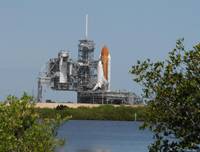
Shuttle Atlantis ready on its launchpad. NASA/Ken Thornsley
|
Space
Shuttle preparing for launch on 8 June 2007
Extracts from a NASA
news release dated 31 May 2007.
NASA senior managers selected June 8 as the official launch date for
space shuttle Atlantis. 7 astronauts are scheduled to lift off on
mission STS-117 to the International Space Station.
During the 11-day mission and three spacewalks, the crew will work with
flight controllers at NASA's Johnson Space Center, Houston, to install a
17-ton segment on the station's girder-like truss and deploy a set of solar
arrays. The mission will increase the International Space Station's power
capability in preparation for the arrival of new science modules from the
European and Japanese space agencies.
Astronaut Clayton Anderson will replace current station crew member Sunita
Williams, who has lived on the station since December. Williams will return
to Earth on Atlantis. |
2. Astronomy news from around the world |
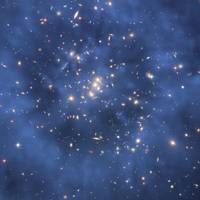
Note that the blue colour is only a representation of how the dark
matter's gravity distorts light waves from background galaxies, it is not
the dark matter itself! Dark matter hasn't been seen yet as it doesn't
reflect light. NASA/ESA/JHU
|
Hubble
sees ghostly ring of dark matter around galaxy cluster
Hubble ESA
Information Centre news
release dated 15 May 2007
Astronomers using NASA's
Hubble Space Telescope have discovered a ghostly ring of dark matter that formed long ago during a titanic collision between two massive galaxy
clusters. The ring's discovery is among the strongest evidence yet that
dark matter exists. Astronomers have long suspected the existence of the
invisible substance as the source of additional gravity that holds
together galaxy clusters. Such clusters would fly apart if they
relied only on the gravity from their visible stars. Although
astronomers don't know what dark matter is made of, they hypothesize that it
is a type of elementary particle that pervades the universe. Dark matter
makes up the bulk of the universe's material and is believed to make up the
underlying structure of the cosmos.
The Hubble composite
image at the left shows the ring of dark matter in the galaxy cluster Cl
0024+17. The ring-like structure is evident in the blue map of the cluster's
dark matter distribution. The map was derived from Hubble observations of how
the gravity of the cluster distorts the light of more distant galaxies, an optical
illusion called gravitational lensing.
Although astronomers
cannot see dark matter, they can infer its existence by mapping the distorted
shapes of the background galaxies. This map is superimposed on
a "Hubble Advanced Camera for Surveys" image of the cluster taken
earlier in November 2004. Read full
article. |
One of the most energetic events ever detected in
space
Chandra Press
Room article dated 30 May 2007
NASA's Chandra X-ray Observatory captured a sight of awesome upheaval. It has
seen an arc of incredibly hot gas extending over two million light years,
which requires one of the most energetic events ever detected. Although
astronomers cannot exactly say what formed this arc of gas, they can provide
two interesting explanations:
The favored explanation is that two massive galaxy clusters are undergoing
a collision at a speed of 6.4 million km/h. Shock waves generated
by the collision of the two clusters' hot gas clouds could produce a
sharp change in pressure along the boundary where the collision is occurring,
giving rise to the observed arc-shaped structure.
Another possible explanation is that the disturbance was caused by an outburst generated by the infall of matter into a supermassive black hole located in a central galaxy. The black hole inhales much of the matter but
expels some of it outward in a pair of high-speed jets, heating and
pushing aside the surrounding gas. |
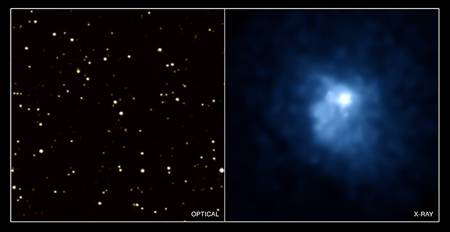
|
The
image on the left is what you see if you look at this area in optical
wavelengths. The same area of the sky appears dramatically different when
viewed in X-rays (Chandra image at the right).
An arc-like feature to the lower left in the cluster's hot gas is about 2
million light years long (X-ray image).
Credit: NASA/CXC/CfA/R.P.Kraft;
Optical: Pal.Obs. DSS
Read full
article. |
3. Interesting Space Facts |
NASA's Space Shuttle
-The outside skin of the shuttle can reach temperatures of up to 1
650 °C upon re-entry into Earth's atmosphere.
When the liquid hydrogen in the space shuttle's main engine is burned with
liquid oxygen upon launch, the temperature in the engine's combustion
chamber increase to more than 3 300 °C. Compare these figures with
the Sun's surface temperature of about 6 000 °C... (although the Sun's core
temperature is an estimated 15 million degrees Celsius).
-After lift-off, it takes only eight minutes for the space shuttle to
reach its orbit around Earth and travel at its orbital speed of over 27,300
kilometers per hour (equal to travelling between Bloemfontein and
Johannesburg in only 52 seconds...)
-The turbo pump on the main engine of the Shuttle is so powerful that
it could drain an average family-sized swimming pool in only 25 seconds.
-The main engine of the space shuttle weighs only 1/7th as much as a
train locomotive engine does, but delivers as much horsepower as 39
locomotives.
-Kennedy Space Centre's two "Crawlers" are the largest
tracked vehicles on Earth. They are used to transport the shuttle on its
platform from the Vehicle Assembly Building (VAB) to the launch pad, but
takes almost 5 hours to do so at 1.6 km/h!
NASA Human Spaceflight website |

The planet Neptune, photo taken by the venerable Voyager 2 space probe. Credit:
NASA-JPL.
|
Neptune was the first planet discovered using mathematical prediction rather than through telescopic observations. Disturbances in the orbit of
Uranus led astronomers to theoretically determine Neptune's existence. It was
subsequently found by telescope.
Neptune is the 8th planet from the Sun and the 4th largest in the solar system.
As with Uranus, Neptune is commonly referred to as an "ice giant",
consisting of molten rock and metal in its core surrounded by a mantle of icy rock, water, ammonia and methane.
The planet's vast atmosphere consists mostly of hydrogen and helium. Its blue appearance is due to a small
presence of methane. Neptune has the strongest winds of all the
planets; some has been measured moving as mush as 2,100 km/h.
The planet has a very faint ring system. It has 13 discovered moons,
of which Triton is the largest. Neptune has not been orbited by a
satellite yet: the famous Voyager 2 probe did however, fly by Neptune while on its tour of the outer gas giants.
More at Wikipedia.org.
This is the 9th part in a 12-part series about
the Solar System. |
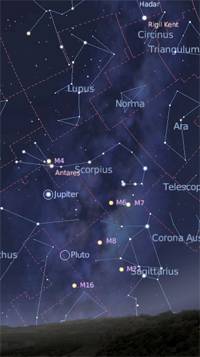
Looking east in the June 2007 evenings towards Scorpius, with bright Jupiter
dominating the view.
Credit: Stellarium.
|
Planets
- mid June 2007
Mercury is visible in the evening sky
until the 11th of June. Venus shines
remarkably bright in the evening a few hours after sunset in the north-west,
in the direction of the Cancer constellation (distance from Earth: 0.65 AU,
magnitude -4.2). Mars rises in the morning skies around 3h00. Jupiter can be seen throughout the night, located
below Scorpius. It shines quite bright! (distance from Earth: 4.3 AU,
magnitude -2.2). Saturn can be seen in the evening skies, until about 21h00, in the constellation of
Leo. For telescopes only: Uranus can be seen from after midnight, while Neptune is visible for most of the night.
Stars &
Constellations - June 2007
There is still some time to catch the autumn constellations such as Corvus,
Crater, Hydra, Leo etc. If you are interested in galaxy hunting, the time is
NOW! Especially well placed in the evening sky is Virgo, full of faint
galaxies. Scorpius is rising in the east, leading in deep winter
for its southern hemisphere observers. It is littered with beautiful
binocular objects (see below). Bootes, with its bright star Arcturus
is rising in the north-east. The Southern Cross, with Centaurus surrounding
it, is situated high in the southern skies.
Deep Sky Objects
for binoculars and telescopes - June 2007
Binoculars:
Coma Berenices Star Cluster (even visible with the unaided eye) above
the northern horizon.
M6: "Butterfly Cluster". Beautiful small open cluster below
the tail of Scorpius (left of M7).
M7: "Ptolemy's Cluster". Large and bright open cluster also
below the Scorpion's tail
Telescopes:
NGC 6231: Bright open cluster in the tail of Scorpius, surrounded by
the "Lizard" star field.
NGC 3242 (faint!) "The Ghost of Jupiter" planetary nebula. For
larger telescopes.
M83 (faint!) Spiral galaxy in Hydra
called the Southern Pinwheel.
M104 (faint!) The Sombrero Galaxy. No doubt one of the best galaxies in
the night sky.
Full Moon on 1 June and 30 June
New Moon on 15 June
Venus close to M44 Beehive cluster on 13 June 2007 (north-west)
Sources: detailed sky phenomena can be found in the 2007 Sky Guide
handbook. Where are all these objects situated? Contact us for a free sky map, or
download Stellarium. |
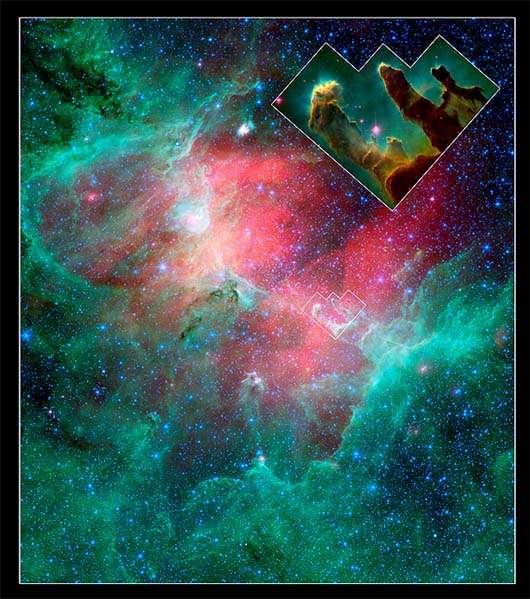
"This
majestic view taken by NASA's Spitzer Space Telescope tells an untold
story of life and death in the Eagle nebula, an industrious star-making
factory located 7,000 light-years away in the Serpens constellation. The
image shows the region's entire network of turbulent clouds and newborn stars in infrared light". More
info.
Image
credit:
NASA/JPL-Caltech/N.
Flagey (IAS/SSC) & A. Noriega-Crespo (SSC/Caltech) |
7. Astronomy in Southern Africa |
ASSA
National's website updated
The website of
the National Astronomical Society of Southern Africa has been updated with
the latest news in SA Astronomy and sky information for June 2007: http://assa.saao.ac.za
Latest on SKA/meerKAT
Read more about one of South Africa's most exciting astronomy projects.
The latest newsletter can be found at http://www.ska.ac.za/newsletter/index.html.
SA's second satellite: launch postponed until admin issues are resolved
Read an article on Mail
& Guardian's website regarding the satellite's launch delay.
Want to build your own telescope? Join an astronomy club?
The best way to start with astronomy and star gazing as a hobby is to let
someone familiar with it show you how to start. Go to a meeting of an astronomy
club in Southern Africa. |
|



